The AMD Threadripper 2 CPU Review: The 24-Core 2970WX and 12-Core 2920X Tested
by Ian Cutress on October 29, 2018 9:00 AM ESTHEDT Performance: Rendering Tests
Rendering is often a key target for processor workloads, lending itself to a professional environment. It comes in different formats as well, from 3D rendering through rasterization, such as games, or by ray tracing, and invokes the ability of the software to manage meshes, textures, collisions, aliasing, physics (in animations), and discarding unnecessary work. Most renderers offer CPU code paths, while a few use GPUs and select environments use FPGAs or dedicated ASICs. For big studios however, CPUs are still the hardware of choice.
All of our benchmark results can also be found in our benchmark engine, Bench.
Corona 1.3: Performance Render
An advanced performance based renderer for software such as 3ds Max and Cinema 4D, the Corona benchmark renders a generated scene as a standard under its 1.3 software version. Normally the GUI implementation of the benchmark shows the scene being built, and allows the user to upload the result as a ‘time to complete’.
We got in contact with the developer who gave us a command line version of the benchmark that does a direct output of results. Rather than reporting time, we report the average number of rays per second across six runs, as the performance scaling of a result per unit time is typically visually easier to understand.
The Corona benchmark website can be found at https://corona-renderer.com/benchmark
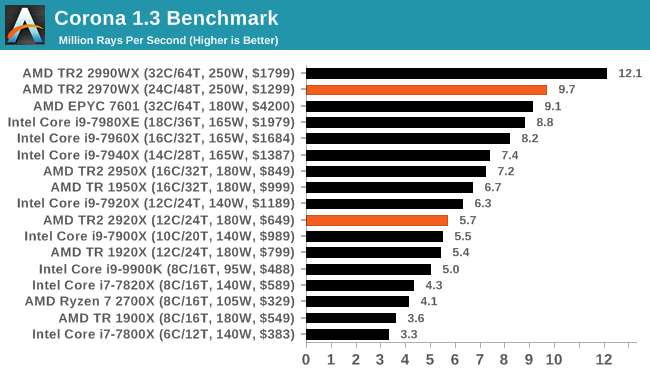
Corona scales well with cores, although memory bandwidth also helps. The 2970WX sits behind the 2990WX amd the 2920X sits behind the 2950X, as expected.
Blender 2.79b: 3D Creation Suite
A high profile rendering tool, Blender is open-source allowing for massive amounts of configurability, and is used by a number of high-profile animation studios worldwide. The organization recently released a Blender benchmark package, a couple of weeks after we had narrowed our Blender test for our new suite, however their test can take over an hour. For our results, we run one of the sub-tests in that suite through the command line - a standard ‘bmw27’ scene in CPU only mode, and measure the time to complete the render.
Blender can be downloaded at https://www.blender.org/download/
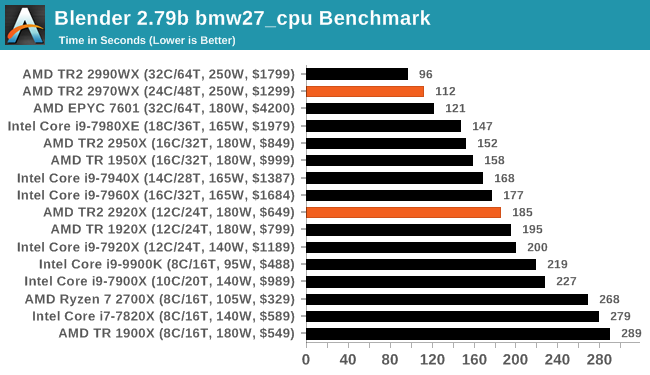
Blender is also another render that likes a mix of cores and memory, being able to put all of the the 2990WX cores to good use. The 2970WX also comes in under two minutes on this test, while the 2920X only just beats the previous generation 1920X.
LuxMark v3.1: LuxRender via Different Code Paths
As stated at the top, there are many different ways to process rendering data: CPU, GPU, Accelerator, and others. On top of that, there are many frameworks and APIs in which to program, depending on how the software will be used. LuxMark, a benchmark developed using the LuxRender engine, offers several different scenes and APIs.
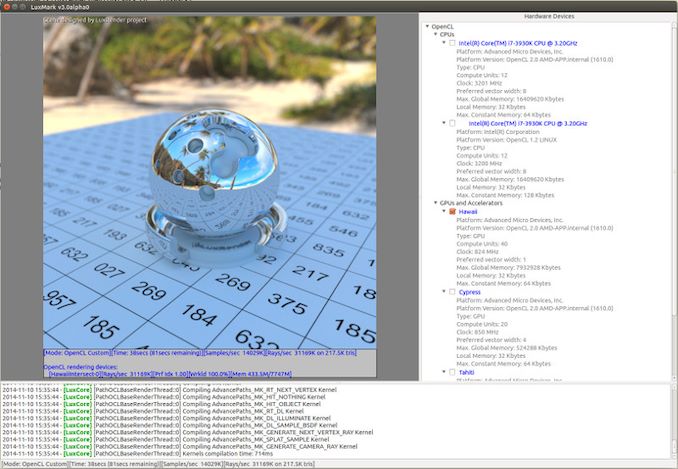
Taken from the Linux Version of LuxMark
In our test, we run the simple ‘Ball’ scene on both the C++ and OpenCL code paths, but in CPU mode. This scene starts with a rough render and slowly improves the quality over two minutes, giving a final result in what is essentially an average ‘kilorays per second’.
It has been pointed out to us that LuxMark is affected by the Spectre/Meltdown patches, so consider this more of a synthetic test of different code paths.
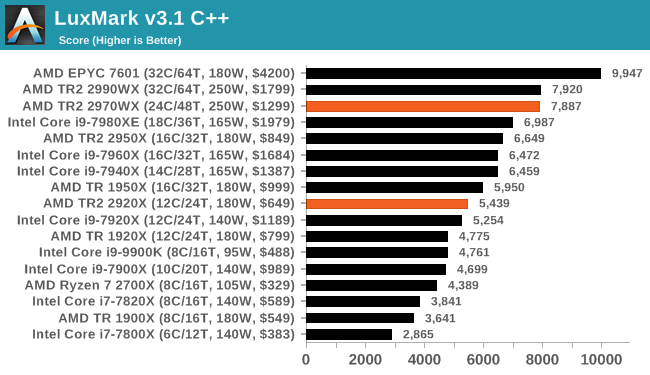
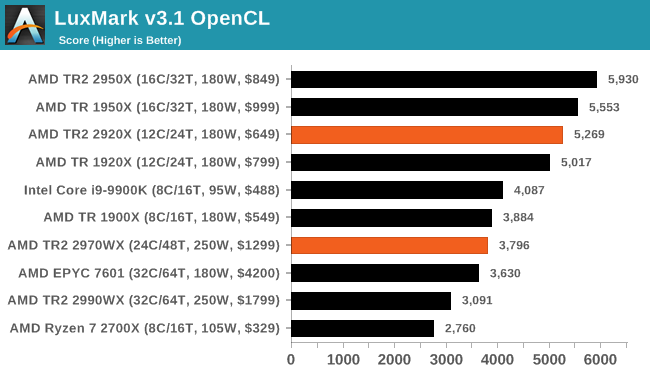
LuxMark in C++ mode seems to be able to take advantage of the extra memory bandwidht on the EPYC platform. Our Skylake-X processors never seem to be able to run the OpenCL model, but we see there are problems above 16 cores in this part of the test.
POV-Ray 3.7.1: Ray Tracing
The Persistence of Vision ray tracing engine is another well-known benchmarking tool, which was in a state of relative hibernation until AMD released its Zen processors, to which suddenly both Intel and AMD were submitting code to the main branch of the open source project. For our test, we use the built-in benchmark for all-cores, called from the command line.
POV-Ray can be downloaded from http://www.povray.org/
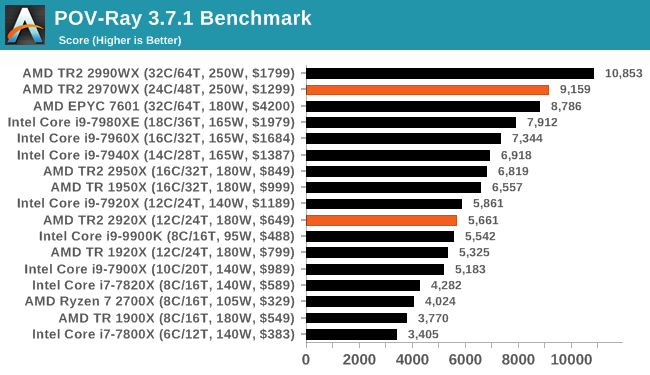


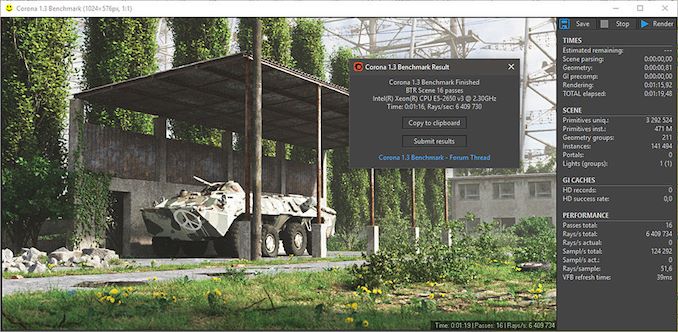








69 Comments
View All Comments
snowranger13 - Monday, October 29, 2018 - link
On the AMD SKUs slide you show Ryzen 7 2700X has 16 PCI-E lanes. It actually has 20 (16 to PCI-E slots + 4 to 1x M.2)Ian Cutress - Monday, October 29, 2018 - link
Only 16 for graphics use. We've had this discussion many times before. Technically the silicon has 32.Nioktefe - Monday, October 29, 2018 - link
Many motherboards can use that 4 additionnal lanes as classic pci-ehttps://www.asrock.com/mb/AMD/B450%20Pro4/index.as...
mapesdhs - Monday, October 29, 2018 - link
Sure, but not for SLI. It's best for clarity's sake to exclude chipset PCIe in the lane count, otherwise we'll have no end of PR spin madness.Ratman6161 - Monday, October 29, 2018 - link
Ummm...there are lots of uses for more PCIe besides SLI ! Remember that while people do play games on these platforms, it would not make any sense to buy one of these for the purpose of playing games. You buy it for work and if it happens to game OK then great.TheinsanegamerN - Tuesday, October 30, 2018 - link
Is it guaranteed to be wired up to a physical slot?No?
then it is optional, and advertising it as being guaranteed available for expansion would be false advertising.
TechnicallyLogic - Thursday, February 28, 2019 - link
By that logic, Intel CPUs have no PCIE slots, as there are LGA 1151 Mini STX motherboards with no x16 slot at all. I think a good compromise would be to list the CPU as having 16+4 PCIE slots.Yorgos - Friday, November 2, 2018 - link
for clarity's sake they should report the 9900k at 250Watt TDP.selective clarity is purch media's approach, though.
2700x has 20 pcie lanes, period. if some motherboard manufacturers use it for nvme or as an extra x4 pcie slot, it's not up to debate for a "journalist" to include it or exclude it, it's fucking there.
unless the money are good ofc... everyone has their price.
TheGiantRat - Monday, October 29, 2018 - link
Technically the silicon of each die has total of 128 PCI-E lanes. Each die on Ryzen Threadripper and Epyc has 64 lanes for external buses and 64 lanes for IF. Therefore, the total is 128 lanes. They just have it limited to 20 lanes for consumer grade CPUs.atragorn - Monday, October 29, 2018 - link
Why are the epyc scores so low across the board? I dont expect it to game well but it was at the bottom or close to it for everything it seemed